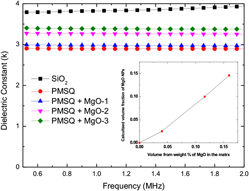Published online by Cambridge University Press: 22 May 2013

The use of MgO nanoparticle (NP) loaded poly(methylsilsesquioxane) (PMSQ) as a low temperature processable composite dielectric has been investigated. The composite dielectrics have been synthesized using facile ultrasonic mixing of trimethoxymethylsilane (MTS), butanol (n-BuOH) and deionized water at 60 °C, with MgO loadings from 0.096 up to 0.39 wt% of the initial solution. Thin films of the composite materials produced have shown an increase in dielectric constant from 2.8 for raw PMSQ up to 3.4 for the 0.39 wt% loaded PMSQ + MgO NP composites at frequencies up to 2 MHz, comparable to 3.9 for SiO2. The composite dielectric materials have shown suitability as a dielectric material for a P3HT OFET, with the performance comparable to a standard SiO2 dielectric control sample.